The art of barbecue is often associated with the expertise of a pitmaster. A common practice undertaken by most pit masters is to wrap the meat halfway through smoking. Wrapping helps keep the meat tender by locking moisture during smoking, speeding up the procedure. But when it comes to wrapping, the long-standing debate has been- butcher paper Vs. Foil.
Meat can be wrapped either in butcher paper or foil and is an effective method to cut down final hooking hours without drying out the meat. Both wrapping techniques have several advantages, but which one is preferable- butcher paper Vs. Foil is a question we will explore in detail in the following discussion.
Per the various preferences, some people swear by the effectiveness of aluminum foil. In contrast, others rely on butcher paper, so let’s get to determining the differences they both have.
Butcher Paper Vs. Foil
Deciding on butcher paper vs. foil is not as easy as it may seem and depends on various factors, such as what kind of meat is being smoked, where the smoking is taking place, and whether there are any existing time constraints.
However, wrapping is a renowned technique used by backyard cooks and professional pit masters during barbecues. If you are wondering what wrapping is, it is defined by the meaning: you wrap the meat in butcher paper or the foil.
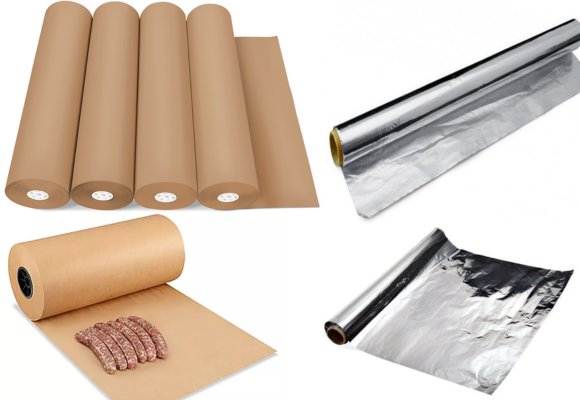
Generally, the meat is smoked without wrapping for the first half, where the bark is smoked and developed. Meanwhile, the meat takes up the smoky flavor imparted from the underneath burning wood.
Later, the meat is tightly wrapped up in whatever paper you want, and according to the kind of meat that is smoked in butcher paper or foil, ample moisture can be locked inside the food, and the meat does not dry out.
Butcher Paper
Butcher paper composed from wood pulp is one of the widely used and most traditional methods for wrapping and can be found in a varying range of colors, all generally indicating a different use. Specifically, you must purchase pink or peach-colored butcher paper for wrapping the barbecue.

Through its absorbent qualities, the butcher paper ensures that the meat’s bark is protected while keeping the moisture inside, preventing it from escaping. Though butcher paper will absorb some moisture, unlike aluminum foil, it will resist liquid from evaporating significantly.
Compared to aluminum foil, the only potential drawback of using butcher paper for wrapping is that it can often slow down the rate of cooking. For example, if you have wrapped a brisket in a butcher paper to smoke, you will hit a stall, and the meat will take longer to smoke.
If the same brisket were wrapped and smoked in aluminum foil, it would rather insulate the meat and keep it at a steady temperature.
An essential aspect to consider in the use of butcher paper is its interaction with evaporation. Unlike tin foil, butcher paper allows for a certain degree of moisture release. This controlled evaporation is crucial in preventing the meat from becoming too soggy, ensuring that the bark retains its desired texture while the meat remains moist and flavorful.
Pros:
- Protects bark
- More pronounced, stronger smoke flavor
- Meat is braised
Cons:
- Heat passes through
- Cooking time is longer
- To check the temperature, meat has to be unwrapped
Foil
A key component in the wrapping debate is the use of table foil, commonly known as aluminum foil. A popular choice, aluminum foil, is also commonly known as the “Texas Crutch” and is an easily available and accessible household item stored in many Americans’ houses, dissimilar to butcher paper.
Due to the numerous and advantageous qualities of aluminum foil, most people choose to keep it around all the time, but they still may not be so keen on purchasing and storing a roll of butcher paper, which, compared to foil, is a bit costly.
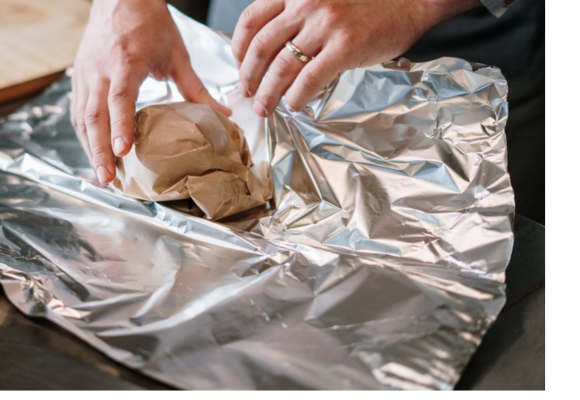
Foil is not only easy to use, but through its heat insulation characteristics, it assists in speeding up cooking in the smoker, trapping meat’s moisture, and permitting the food to steam adequately.
Yet another great aspect of using foil for wrapping is that it does not soak up meat’s juices and lets the meat braise and sit in its juices while smoking. However, you must be very vigilant as to when the meat is to be wrapped in foil because if not, then the bark of the brisket can be compromised.
If meat is wrapped early on in the foil, the bark will slide off the brisket, so ensure that the bark has been cooked and is ready to be wrapped, which typically happens at 165F. Also, always use heavy-duty foil as it is an amazing option for wrapping sharp bones, pork ribs, and brisket and will not puncture the foil despite exposure to heat.
Pros:
- Cooking time is faster
- Meat braises in juices
- Checking temperature is easy by piercing the foil
- Consistent temperature
Cons:
- Less smoky flavor
- Compromises bark through steam
How To Wrap Meat In Butcher Paper Vs. Foil?
Now that you have understood the differences between butcher paper Vs. Foil, you know the pros and cons of both kinds of wrapping options, so it is time to learn how to wrap the meat. The meat has to be wrapped in a particular manner, and fortunately, the wrapping process for butcher paper and foil is almost identical.
Begin by cutting out two large sheets of butcher paper and foil, and make sure the length of the sheet you cut out should be four times larger than your meat. Place the first sheet over a flat surface such that the longest edge of the sheet is perpendicular, facing towards you.

Then, overlap the second sheet over the first by half the width. Then, lengthwise, place the meat on the butcher paper or the foil, ensuring that the meat is at least a foot away from the sheet’s edge.
At this point, and before progressing any further with wrapping the meat, you can sprinkle some vinegar over the sheet to moisten the meat. Next up, fold one edge over the meat and tightly pull it. Do this with all the other remaining edges, keeping in mind that the incoming folds should follow the shape of the meat.
Fold in all sides of the butcher paper or the foil to ensure that the meat is completely covered from all sides and that the final wrapping resembles the meat’s shape.
Before tucking the folds in on the sheet, make sure to smoothen the paper out so every side tucks in securely, and there is no risk of the wrapping unfolding when kept in the smoker. Also, a quick way to double the thickness of the wrapping is to fold the top end of the butcher paper or the foil.
The choice of equipment, such as a pellet grill, also influences the decision between butcher paper and foil. Pellet grills, known for their consistent temperature control and ease of use, can complement both methods of wrapping. However, the unique characteristics of these grills, such as their ability to impart a subtle smokiness, might sway the pitmaster’s preference towards one type of wrapping over the other.
Different Food Items And Their Wrapping
Placing the meat on a rack before wrapping in butcher paper or foil allows for even smoking and heat distribution. This step ensures that every part of the meat receives the same level of attention, resulting in a uniformly cooked and flavored barbecue.
We stated earlier that different kinds of food would be better suited to be wrapped in butcher paper or foil. Therefore, this section will elaborate on whether butcher paper or foil should be used when wrapping brisket, pork ribs, pork shoulder, and beef ribs.
Brisket
Luckily, a brisket can be wrapped in butcher paper and foil for smoking. Whatever you have available can be used to wrap and smoke the brisket.
Supposedly, if you are smoking a brisket in the backyard of your home without any time constraints, then the ideal wrapping would be that of a butcher paper. The paper will exclusively maintain the beautiful bark and let the smoke flavor penetrate each fiber of the brisket for the duration it is kept on the grill.
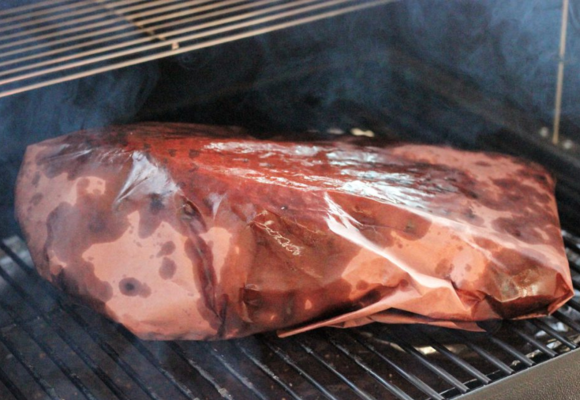
Additionally, less steam will be trapped as the paper is more breathable, and the brisket will be kept crunchy and super crispy without the bark being soggy.
An alternative to wrapping brisket in butcher paper is to wrap it in foil, which will perfectly capture the meat’s juices and fat, and let the meat braise in it after it has been removed from the smoker.
Although with foil, the cooking time will be less, specifically for a brisket, the overly moist environment compromises the bark and sometimes detaches it from the meat. Nevertheless, this does not happen every time but only when you have not been cautious with inspecting the bark and wrapping the brisket while the bark remains uncooked.
Pork Ribs
For pork ribs, aluminum foil is the perfect wrapping option as the ribs will cook in their juices and any sauces or butter you may include as part of the rib’s recipe. Since there is no bark in the pork ribs, you have nothing to be concerned about and can make the most out of the produced steam.
Pork ribs wrapped in aluminum foil will cook quickly as the procedure through the foil has inevitably been sped up, and the ribs will be steamed and insulated faster.
If you have never smoked pork ribs wrapped, then when wrapping them in the foil for the first time, be mindful and keep a keen eye out to check them as they will be smoked way earlier than you may anticipate.
Pork Shoulder
Pork shoulder, after being smoked for six to eight hours, should be wrapped in foil and must be placed in an aluminum trap with butter and apple juice added to the bottom. We recommend adding additional liquids to the aluminum tray as it aids in creating an extra succulent flavor for pork shoulders.
Foil is used here because it will keep the temperature during the smoking even and maintained. Look out; we here are not saying that you should wrap the pork shoulder directly into the foil but should wrap it inside an aluminum tray so the bark is not compromised.
Beef Ribs
The beauty and the greatness of beef ribs indeed lie in the bark that is created during smoking. Recall how wrapping such meats in aluminum foil almost always results in the bark being over or undercooked. Therefore, precisely for beef ribs, the optimal wrapping option is a butcher paper.
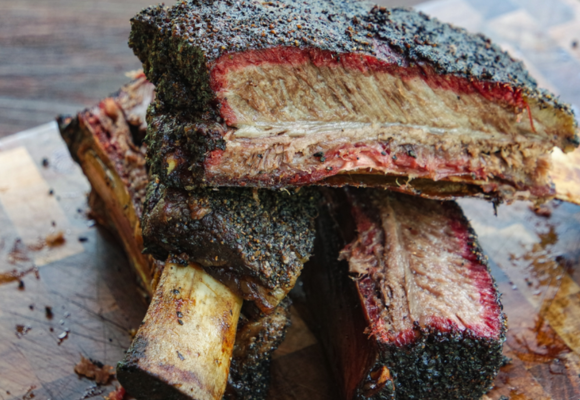
Even if you are using aluminum foil for beef ribs right now, it is better to start employing butcher paper sooner rather than later. The butcher paper will let the smoky flavor be soaked in the meat, which takes the final flavor of the beef ribs up a notch.
Aluminum foil, often the preferred choice for these recipes, ensures that the ribs are not just cooked but are infused with flavors, whether it’s from the meat’s own juices or added sauces and marinades. This technique is particularly important in ribs recipes, where the balance of flavor and texture is paramount.
Most importantly, the butcher paper will gloriously not impact the bark and will let it remain intact with the ribs. Ideally, use two thick, long, and wide sheets of butcher paper to wrap beef ribs and use our proposed wrapping process to ensure the meat is secured.
Thoughts On Wrapping
Wrapping your barbecue meat is not a compulsion but is something that, if done, can result in tender, evenly smoked, moistened meat. A protective layering of butcher paper or foil will fundamentally protect the meat from drying out while fastening the cooking procedure.
Even though it is argued that wrapping compromises the bark of the meat, that is only bound to happen if the meat is wrapped too early. If wrapped at the right time, the bark will not be compromised but prevented from burning, getting too hot, or smoky.
So, wrap your meat away in either butcher paper or foil if you want the best smoking results, but make the right choice- butcher paper Vs. Foil because you would not want to overheat the meat or have the bark slide away.
Conclusion
Professional chefs and pitmasters alike understand the nuances of smoking meat. Their expertise highlights the importance of choosing the right wrapping material, whether it’s butcher paper or tin foil, and the correct use of tools like racks in smoking. The debate for butcher paper Vs. Foil is one of the most heated and ongoing debates. There is no singular answer for what kind of paper should be used for wrapping. Instead, the answer is to be determined through the needs of the meat being smoked and the outcome you are looking forward to achieving.
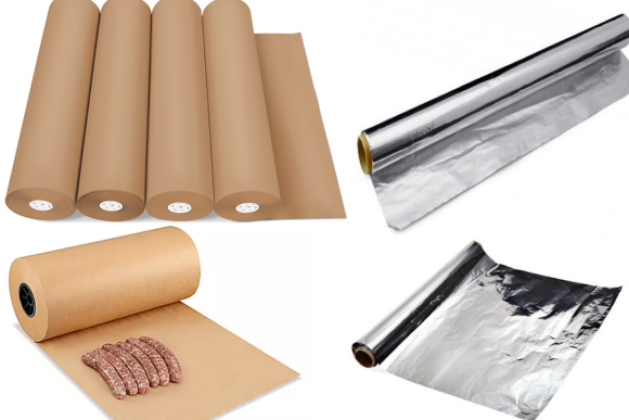
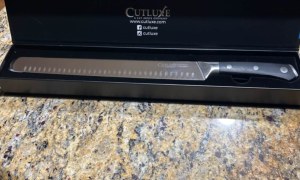
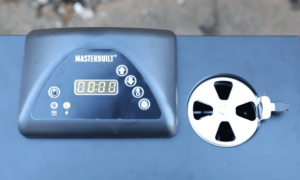
Leave a comment